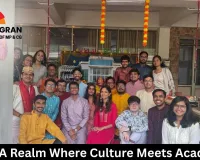Evolution of Military Traditions in the Indian Army: From Ancient Valour to Modern Glory
By – Dr. T. C. Rao, Ph.D.
The Indian Army is far more than a military organization—it is a living reflection of India’s timeless spirit of courage, discipline, and sacrifice. Its customs, rituals, and values are rooted in centuries of martial heritage, evolving from ancient warrior kingdoms into a modern, professional force that protects the nation with honour.
The Army’s traditions blend India’s ancient martial ethos with the discipline and structure inherited from the British era, further refined through decades of war, peacekeeping, and humanitarian service.
These traditions are not mere ceremony they are the moral compass that unites generations of soldiers, inspiring loyalty, unity, and devotion to the motherland.
Ancient Foundations: Dharma and Valour
India’s military traditions trace their origins to the ancient concept of Dharma Yuddha—righteous warfare—as described in the Mahabharata and Ramayana. These epics defined codes of conduct in battle, emphasizing honour, fairness, and respect for the enemy.
The Maurya, Gupta, and Chola empires developed organized and disciplined armies, guided by a deep sense of duty (Kshatriya Dharma).
Soldiers swore oaths of loyalty, performed ritual worship before combat, and honoured fallen comrades through religious rites. Dying in battle was considered sacred—attaining Veergati (martyrdom).
Under Chandragupta Maurya and Emperor Ashoka, the Mauryan Army epitomized discipline and hierarchy. The Chola naval forces, with their flags, formations, and ceremonies, were early examples of the organized traditions that continue in the Indian Army today.
Medieval Era: Honour, Loyalty, and Ethos
The medieval period witnessed the rise of regional warrior traditions—Rajputs, Marathas, and Sikhs—each leaving an indelible mark on India’s martial culture.
Rajputs: Exemplified Veer Bhav (valour) and unwavering loyalty. Rituals such as the Tilak of Victory, Shastra Puja (weapon worship), and divine invocations before battle became central to their ethos.
Marathas under Shivaji Maharaj: Pioneered guerrilla warfare rooted in moral conduct. Shivaji’s strict code forbade harm to civilians and women, underscoring the ideal of ethical warfare.
Sikhs under Guru Gobind Singh: Introduced the ideal of the Sant-Sipahi (Saint-Soldier)—a warrior devoted to both faith and righteousness. The Sikh martial tradition of courage, discipline, and community service continues to influence Indian Army regiments today.
This era cemented the values of bravery, loyalty, and honour—the pillars upon which the Indian Army stands.
British Era: Institutionalizing Military Traditions
The modern Indian Army took structured form under British rule, when indigenous martial traditions were blended with European discipline and organization.
The British introduced systems that shaped the Army’s professional character:
Regimental System: Class-based regiments (Rajput, Sikh, Gorkha, Jat, Dogra, etc.) created strong bonds of identity and unity.
Ceremonial and Mess Customs: Salutes, parades, uniforms, and mess etiquettes were formalized.
Codes of Conduct: Discipline, honour, and duty became sacred principles.
Colours and Insignia: Regimental flags emerged as symbols of pride and devotion, saluted as a mark of loyalty to one’s unit.
While the British Army primarily served colonial interests, it also fostered professionalism and esprit de corps. Indian soldiers distinguished themselves in both World Wars, earning global respect for their courage and loyalty.
Post-Independence: Indianizing the Traditions
After 1947, India retained the regimental system but infused it with national pride and indigenous values. The transition from a colonial to a national army was marked by the integration of Indian cultural and ethical traditions.
Key transformations included:
Indigenized Mottos and Symbols: “Service Before Self,” “Veer Bhogya Vasundhara” (The brave inherit the earth), and “Sarvatra Izzat o Iqbal” (Everywhere with honour and glory) became guiding ideals.
Cultural and Religious Observances: Shastra Puja on Dussehra, Independence Day flag hoisting, and regimental prayer parades became integral to Army life.
Honouring the Fallen: Memorial services, wreath-laying ceremonies, and naming gates and memorials after martyrs reaffirmed the sacred soldier’s bond across generations.
Leaders like Field Marshals K. M. Cariappa and Sam Manekshaw shaped the moral backbone of the Army—emphasizing discipline, integrity, and loyalty to the Constitution. They ensured that the Army remained secular, professional, and apolitical.
Regimental Spirit: The Heartbeat of the Army
The soul of the Indian Army lies in its regimental traditions—unique identities that foster unity beyond caste, creed, or region. Each regiment preserves its battle cry, motto, insignia, and song, echoing centuries of valour:
Rajputana Rifles: “Raja Ramchandra Ki Jai”
Sikh Regiment: “Jo Bole So Nihal, Sat Sri Akal”
Gorkha Rifles: “Jai Mahakali, Ayo Gorkhali”
Madras Regiment: “Veer Madrassi, Adi Kollu”
These war cries ignite courage and reinforce collective pride. Officers’ Mess traditions, regimental bands, and ceremonial parades embody discipline and camaraderie. The Passing Out Parade at academies symbolizes a timeless transition—from cadet to guardian of the nation.
Traditions Forged in War
Every conflict fought by the Indian Army—from 1947 to Kargil—has deepened its legacy of valour and sacrifice.
1947–48: The Army’s first war tested its spirit and defined its leadership culture.
1965 & 1971: Strengthened the ethos of teamwork and regimental pride.
Kargil 1999: Renewed the “lead from the front” tradition—immortalizing heroes like Captain Vikram Batra (“Yeh Dil Maange More”) and Grenadier Yogendra Yadav.
These stories of gallantry are retold in regimental messes and academies, ensuring that every new soldier inherits the courage of those who came before.
Discipline and Civil-Military Ethos
A defining feature of the Indian Army is its unwavering commitment to civilian supremacy and constitutional loyalty. Unlike many militaries in developing nations, India’s Army has remained apolitical and professional.
Its humanitarian role—during disasters, rescue operations, and UN peacekeeping missions—reflects its enduring motto:
“The Nation Comes First, Always and Every Time.”
This ethos embodies the Army’s moral strength and its unbreakable bond with the people.
21st Century Traditions: Modern Spirit, Timeless Core
As the Indian Army advances into the digital era, it continues to evolve while preserving its moral foundation. Modern traditions now include:
Observing Vijay Diwas, Kargil Diwas, and Army Day with national pride.
Inclusion of Women Officers, representing progress and inclusivity.
Creation of Digital Memorials and virtual tributes to martyrs.
Upholding UN Peacekeeping values in the spirit of Vasudhaiva Kutumbakam—“the world is one family.”
Thus, the Army’s traditions remain dynamic—rooted in history, responsive to change, and relevant to the future.
The Soul of Tradition: Naam, Namak, Nishan
“Naam, Namak, Nishan” (Name, Honour, and Insignia) captures the essence of Indian military tradition. Every soldier’s pride lies in upholding his regiment’s honour, remaining loyal to his nation’s name, and protecting the insignia that symbolizes its legacy.
From the icy heights of Siachen to the valleys of the Northeast, these ideals sustain courage, discipline, and unity.
The evolution of military traditions in the Indian Army is a saga of continuity, adaptation, and pride. From the moral codes of Dharma Yuddha to the regimental battle cries of modern warriors, each tradition embodies centuries of faith, courage, and honour.
In an age of changing warfare and technology, the Indian Army’s greatest strength remains its traditions—timeless, unifying, and inspiring. They remind every soldier that service is not for reward or recognition, but for the eternal honour of Bharat Mata.





3.jpg)





